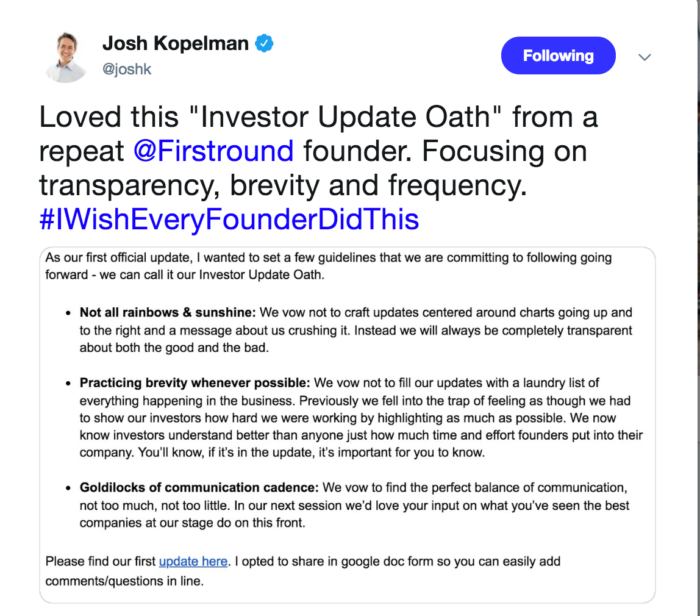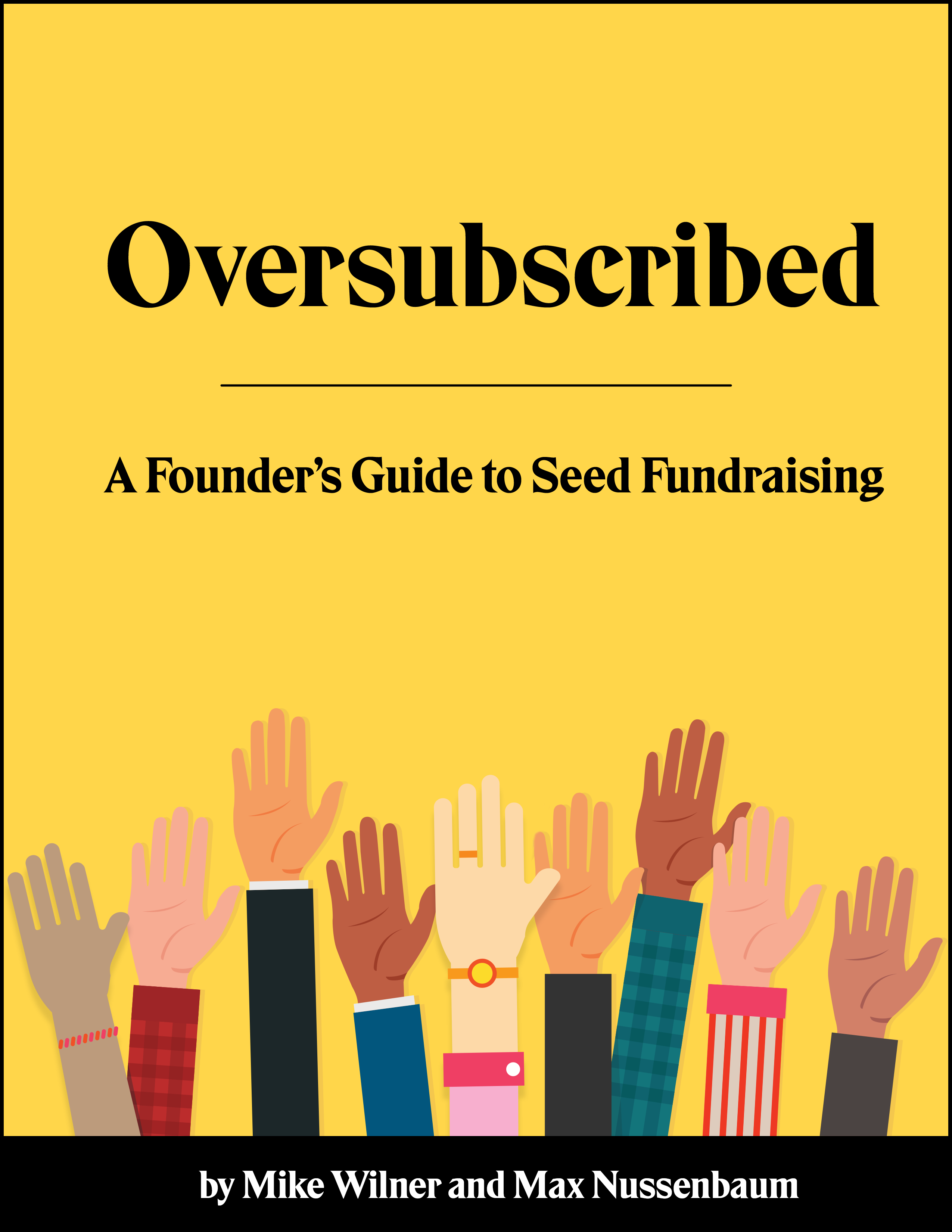Talkin’ ’bout investor updates (Oversubscribed Weekly #9)
January 10, 2019Mike here. This week, we’re mixing up the format and diving a little deeper on a single topic – let us know what you think!
This week we’re diving deep on supporter and investor updates: the emails you send out to your investors and/or supporters at a fixed frequency (usually monthly).
When done correctly, supporter and investor updates can make you a better operator by forcing reflection, make raising a round a lot easier when the time comes, and enable others to help your business.
However, if done incorrectly, writing supporter updates can also cause undue anxiety, cause people to lose trust in you, and undermine your ability to raise money quickly.
Our advice: You should consider having two separate emails that you send out on a monthly basis: (1) a supporter update and (2) an investor update, and you should keep them separate.
Supporter updates are for people who are lightly engaged with your startup and can help. You want to keep them up to date, but you don’t need to tell them every detail of what’s going on. On this list, you can include prospective investors you’ve met, friends and family, former colleagues, and even customers. Supporter updates usually include high level summaries of news, highlights, and challenges facing the business.
Investor updates, on the other hand, are monthly reports that outline the state of the business. They go deeper than supporter updates, tell the unvarnished story of what’s going on, usually including financials and metrics.
So why should you spend time on supporter and investor updates, and why should you keep them separate?
Reason #1: When you’re not fundraising, being able to add investors to a supporter update helps you build trust with them over time, stacking the cards in your favor for when you do raise money.
When raising a round, it’s easier and faster when you already have investors who’ve been tracking you for a while.
Before you’re not fundraising, you’re still likely going to meet angel and VC investors. These can be great folks to genuinely ask for advice, as many of them are former founders and have seen what works and doesn’t work for companies like yours.
Being able to add them to your supporter update is a great way to keep them engaged and allow them to invest in lines, not dots. They’ll be able to track you over time, and once you do decide to fundraise, they’ll be much more comfortable with you. When you turn fundraising mode on, if you announce it privately to your supporter update prior to going out and beginning outreach to investors, you’ll be giving them an exclusive opportunity to jump on the opportunity before others have a chance to, which is something all investors want.
However, you should not add them to your investor update until they invest. Your ability to control the information that prospective investors get about your business is critical to controlling your narrative and generating FOMO when raising. Adding to your investor update undermines that.
Reason #2: Keeping them separate will make you more comfortable being brutally honest with your investors.
In my first startup, I didn’t keep investor and supporter updates separate. As a result, when writing the updates, I subconsciously sugar-coated bad news and was overly optimistic, since I felt uncomfortable sharing such unvarnished versions of the truth to the people on my supporter update list.
One of my investors confronted me about it, and we spent an entire day reading through my supporter updates, pouring through financials, and discussing where the tone in my writing was more optimistic than it should have been based on what the numbers were saying.
After that experience, I decided to keep investor and supporter updates separate. Having separate audiences helped me better deliver on the purpose of each update and tell each audience what they needed to know – nothing more and nothing less.
My investor updates became a lot more data driven and told the unvarnished truth directly, which made it easier for my investors to identify ways that they could help and eliminated the possibility of unpleasant surprises.
As Josh Kopelman tweets below, more founders should write investor updates that are “Not all rainbows and sunshine.”

Reason #3: Sharing progress with supporters can help them help you.
While your investor update list will remain small, you can grow your supporter list significantly, adding anyone who is interested in keeping tabs in how your business is progressing and who you think can provide value. With a larger list, if there’s something you need help with, chances are that someone can help. Including a section called “How you can help” in your supporter update is a great opportunity to make it easy for your supporters to help you, and in some cases, more engaged supporters will be able to read between the lines of your updates and find ways to help you on their own.
In the past, people on my supporter update list have introduced me to eventual investors, referred me customers and partners, and offered their time to talk through strategic decisions that they’ve encountered in the past.
If you were to only send out an investor update, you would be undermining the ability for the folks who are rooting for you to tangibly help.
Reason #4: Taking time each month to write an unvarnished investor update (even if you don’t yet have actual investors) will make you a more thoughtful, purposeful operator.
Creating the responsibility for yourself to write investor updates will force you to be more mindful about the key metrics driving your business and force you to reflect on how the business is doing. This practice will make you a better operator.
Additionally, sharing it with people who you trust and respect provides an opportunity for you to receive feedback on how you’re thinking about the business.
For me, writing investor and supporter updates each month wasn’t just about updating people. It was an activity that required a full day of analyzing progress, reflecting on what was going well and what wasn’t and figuring out how we were driving forward.
As Mathilde Collin, founder of Front tells shares in her amazing First Round Review interview. Having a regular cadence of sending out email updates forced the operational discipline that she claims was the most critical part of her company’s success. Read the article to see precisely how she crafted these emails.


